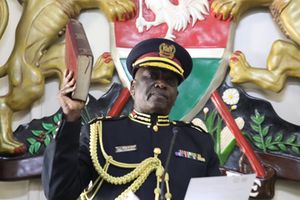Let’s enhance school safety policies to protect learners

Parents at Hillside Endarasha Academy in Kieni, Nyeri County.
What you need to know:
- We should have regular, comprehensive safety audits by external experts on our existing protocols.
- We must also adopt guidance and counselling as a core component in academic delivery.
In the wake of the recent tragic school fire, the Ministry of Education and learning institutions need to take responsibility for the safety of learners. As we mourn, school administrators and policymakers must reflect on the state of schools and commit to avoiding a recurrence of such a tragic incident.
Sadly, we have been on this path before, starting with the Kyanguli fire incident in 2001. Poor safety standards has been a common thread in all the incidents.
A few years ago, the Auditor-General published a damning audit report that indicated inadequate fire safety preparedness in public schools. But this situation also prevails in private and mission schools bound by the Ministry of Education Safety Standards Manual for Schools in Kenya (2008).
The Auditor General, in the 2020 report, however, established that implementation of fire safety measures has faced a number of challenges, such as inadequate infrastructure, limited training on safety preparedness, and insufficient guidance and counselling.
Health and safety policies
In addition to striving for academic excellence, we must unite in a common bond to guarantee student safety by proactively auditing and enhancing our occupational health and safety policies.
For example, we should have regular, comprehensive safety audits by external experts on our existing protocols. Besides acquiring fire-fighting equipment and training all school stakeholders in fire safety protocols, we must maintain basic standards, including identifying clearly labelled fire assembly points and evacuation maps.
These audits should assess everything from fire alarm systems and evacuation routes, to staff training and emergency response plans. Schools must also foster a safety culture by engaging the school community in safety drills and feedback sessions. We must also adopt guidance and counselling as a core component in academic delivery.
Updating safety protocols based on audit findings and real-life scenarios ensures they remain robust and practical. Investing in advanced fire detection technology and maintaining fire safety equipment can further mitigate risks.
Health and safety committee
Furthermore, I urge the construction industry to play a significant role in ensuring safety in educational environments. This can be achieved by incorporating safety features, such as steel doors, that can help contain fires and ensuring clear fire escape routes by shunning steel grilled windows in single-storey buildings or lower levels.
Ensuring that there are living quarters for relevant adults within the student dorms to provide guidance to students in case of an emergency is crucial.
Every learning institution must have a fully functioning health and safety committee. These committees play a crucial role in the day-to-day management of health and safety risks, ensuring swift decision-making and risk mitigation as issues arise. The pain is raw, and we must work to ensure that this country never experiences such a tragedy again.
Mr Khaemba, a director of Nova Pioneer Schools, is a former principal of Alliance High School and founding dean of the African Leadership Academy





